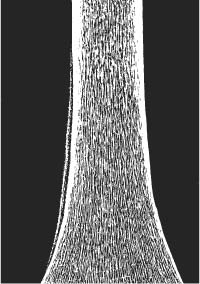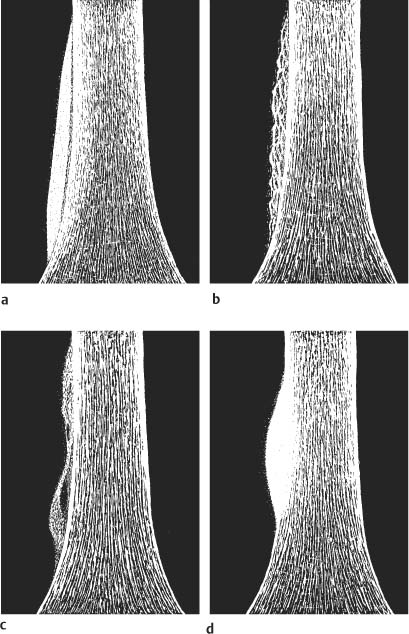3 Periosteal Reactions A periosteal reaction is a common response to a variety of insults to the bone. Important differential diagnostic clues may be obtained from both patterns and locations of periosteal reactions. After an acute incidence, it usually takes three weeks before a periosteal reaction can be diagnosed radiographically. Periosteal reactions should be classified as either solid or interrupted. Each of these two basic forms of periosteal reaction consist of several subtypes. Furthermore, it appears useful for the differential diagnosis to discriminate between conditions with localized or generalized periosteal reactions. Solid periosteal reactions can be thin (1 mm or less in thickness) or thick (2 mm or more). A thin periosteal reaction might represent an early stage of a highly aggressive bone lesion or a chronic, benign process (Fig. 3.1). On the other hand, a thick periosteal reaction usually suggests a benign condition. Thick periosteal reactions may be further subdivided into straight, elliptical, and undulating, each subtype suggesting somewhat different diagnostic possibilities (Fig. 3.2). An interrupted periosteal reaction, in general, signals an acute and rapidly progressing process requiring immediate attention. These periosteal reactions can be laminated (“onion skin”), perpendicular (“sunburst”), or amorphous (Fig. 3.3). A destructive bone lesion associated with any interrupted periosteal reaction suggests acute osteomyelitis or a malignancy. A local elevation of the periosteum that is calcified at the site of its bone insertion is known as “Codman’s triangle” (Fig. 3.3b). Originally considered as a sign of a malignant bone neoplasm, it has been recognized that it can also occur with benign processes such as osteomyelitis, subperiosteal hemorrhage, and fracture. When the periosteal reaction eventually blends with the adjacent cortex, cortical thickening occurs. However, cortical thickening may also develop by excessive endosteal or periosteal new bone formation without stripping the periosteum away from the cortex. The differential diagnoses of various bone lesions with periosteal reactions are discussed in Table 3.1. Under a variety of degenerative, traumatic and inflammatory conditions, a periostitis is found at the insertions of many tendons and ligaments causing the appearance of “whiskering” (Fig. 3.4). The most common location is the pelvis, where the iliac crests, the ischial tuberosities and the ischiopubic rami are affected. Other sites of extrapelvic involvement include the femoral trochanters, the patella, the calcaneus, the dorsum of the foot, the inferior clavicular margin at the attachment of the coracoclavicular ligament, the humeral tuberosities, and the olecranon. As the periostitis progresses the “whiskers” become more prominent, and may transform into spurs or other bony excrescences referred to as enthesophytes. They tend to remain relatively ill-defined or fluffy in ankylosing spondylitis (Fig. 3.5), Reiter’s syndrome and psoriasis. In these inflammatory conditions, erosions or sclerosis of the adjacent bone may be associated. Fig. 3.1 Thin (1 mm or smaller) periosteal reaction. This is an indeterminate finding, since it may indicate a chronic benign process that progresses slowly, if ever, to a solid thick periosteal reaction; or it may represent the earliest stage of an aggressive bone lesion that progresses rapidly to an interrupted periosteal reaction. Fig. 3.2 Solid periosteal reactions indicating a benign bone lesion. a Thick (2 mm or larger) periostea! reaction. b Undulating periosteal reaction. c Periosteal cloaking. d Elliptical periosteal reaction. The enthesophytes in diffuse idiopathic skeletal hyperostosis (DISH) (Fig. 3.6) are bilateral and symmetrical, but without adjacent erosions or reactive bone sclerosis. These spurs are well demarcated and often irregular in outline, especially in the calcaneus. Degenerative disease of tendons and ligaments in the elderly may produce similar enthesophytes, but they tend to be less prominent and less symmetric. Localized spurring at the insertions of tendons and ligaments occurs in conjunction with chronic stress or as sequelae of an old injury. Spur formations are commonly found in the calcaneus, patella and trochanters with acromegaly
![]()
Stay updated, free articles. Join our Telegram channel

Full access? Get Clinical Tree










